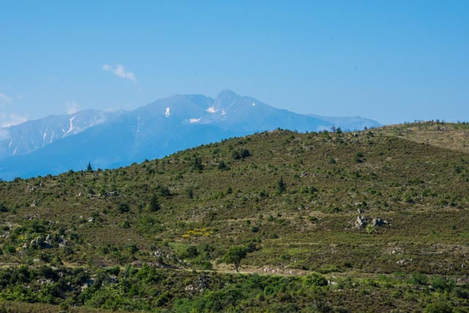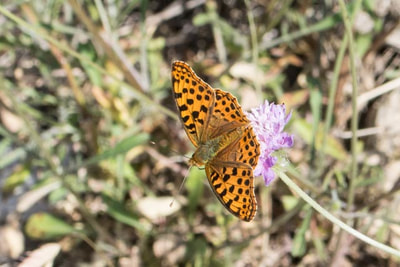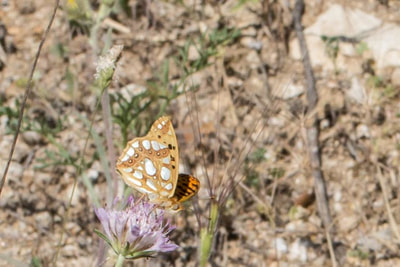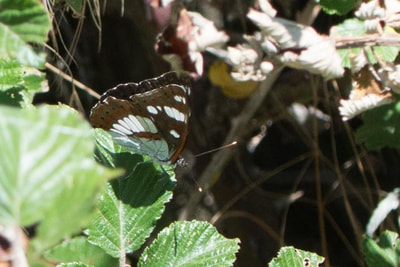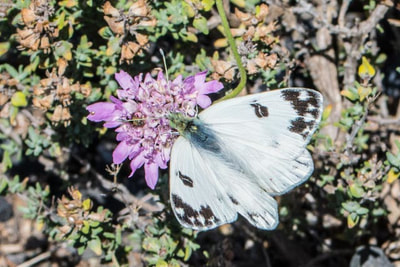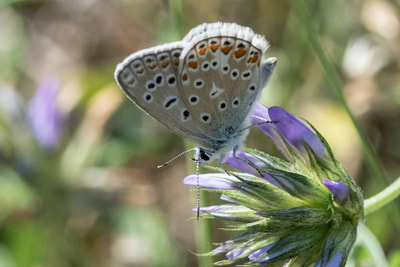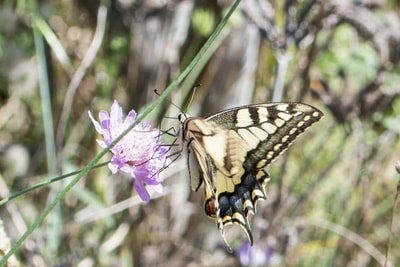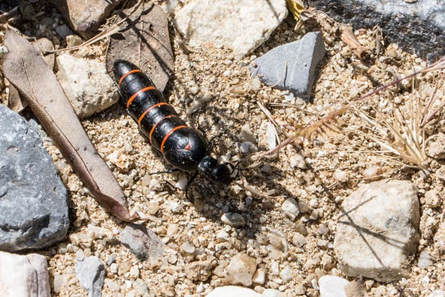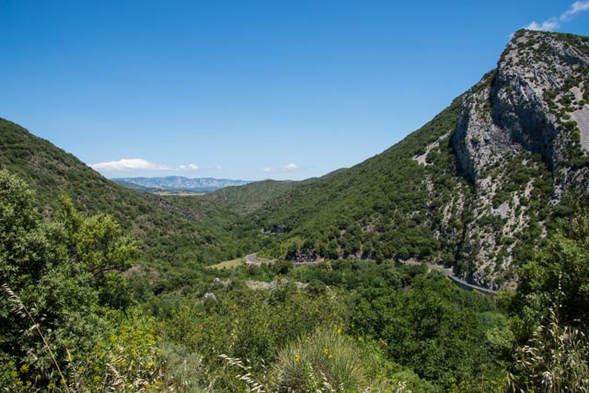Around mid June, Bruce and I headed to a new area to look for butterflies. Our expectations were high, following a tip-off from members of the GOR who, five days earlier, had seen 34 different species there. Their list included the elusive, splendidly named two-tailed pasha, which Bruce hadn't seen before and I'd only briefly glimpsed once or twice.
At Îlle-sur-Têt we headed north-west, into unfamiliar territory beyond les Orgues. The winding road gently climbed, offering spectacular views of the north side of Canigou - a side we rarely see - with its remnants of snow stubbornly refusing to melt. After passing through the little village of Mantalba-le-Château and tiny hamlet of Trévillach, we pulled into a surprisingly big car park in the middle of nowhere, on the crest of a hill. According to our map, this was our destination: le Col des Auzines.
For June, it was very hot, but also very windy, which didn't bode so well for butterfly hunting. Photos are often essential for identification - especially of the blues and fritillaries - and even if we could hold our cameras still enough in these blowy conditions, the butterflies were unlikely to settle for long.
Loaded up with kit and one dog on a lead, we set off down the only visible dirt track. The terrain was more akin to the Corbières than most of the Albères: few trees on the slopes, more scrub, with occasional rocky outcrops. Shrubs seemed to be predominantly rock rose (which had stopped flowering long ago), gorse, broom, and what I think was some kind of myrtle. To our surprise - considering the tip-off - there weren't many plants in flower, and no sign of any running water nearby to attract butterflies in numbers.
In the hope that the habitat might change further on, we continued. A wooded gully fell away to our left, whose trees and impenetrable undergrowth indicated the presence of water in other seasons. Hillsides to our right.
A few butterflies began to make an appearance - Spanish gatekeepers and large walls for the most part, skittishly leading us further down the track. A clouded yellow and one or two Cleopatras fluttered past without stopping. Most couldn't have stopped if they'd wanted to.
What brought us to a sudden halt, however, was a loud, harsh, bark, echoing up from the gully on our left. The kind of sound that lifts the hairs on the back of your neck. Whatever made it was big, not canine. Bruce and I looked at each other, eyebrows raised, while my dog "pointed", sniffing and straining to give chase. Was it a stag? Do stags call much, outside the rutting season? The bark continued intermittently, moving slowly, steadily up the gully, roughly in the same direction as us. We couldn't see a thing through the vegetation but nor did we hear a single twig crack or leaf rustle. We moved on too and, when we reached a left hand bend, the animal barked again, somewhere above us now, on our right. It had crossed the path perhaps seconds before we got there. As it moved further away, my dog was desperate to follow. Given the expanse of wildness here, it was tempting to think the beast was a lynx (they can make a bark-like sound, and sightings are occasionally reported further north, in the Corbières), however I thought it more likely to be a hind. (Robin has since suggested roe deer buck or doe, as they have a different annual cycle from the red, giving birth and rutting much earlier in the year.)
Just ahead we discovered a bigger flower patch (scabious mostly) with butterflies, so we stopped, unloaded rucksacks, and hung around for a while - cameras poised. It was here where we found a single, stubby strawberry tree (Arbutus unedo). We'd been looking out for them because they are the larval food plant of pashas. Where there are Strawberry trees, the butterflies are often in abundance, so it's said. This one was in a small fenced off area (more shrine than garden, with no habitable building for miles), so we didn't think it was self-seeded.
One or two pashas did whizz by (or the same one once or twice), but we really only got a fleeting impression of size (similar to swallowtails) and a flash of orange edging to dark brown wings. On a still day they glide like swallowtails too. As their name suggests, they have two long "tails". Underside wing markings are more ornate than the uppers, but we needed the butterflies to settle, wings closed, in order to see those. They didn't co-operate so our ambition to observe them properly is put forward to another year.
Species that did settle included a small tortoiseshell, swallowtail and quite a few whites (Bath and Iberian marbled). Several blues too, photos of which subsequently had both of us in a head-scratching, fidget-inducing spot-the-difference exercise, trying to separate the common from the Chapman's and Escher's. Not to mention the expletive-triggering Ilex verus False Ilex hairstreak challenge. For once, even the fritillaries proved easier. A highlight of the day was a white admiral. These probably aren't scarce but I hardly ever see them.
Click on photos for larger image
In all, we idenitifed just 17 species, against the 34 seen only a few days earlier on a still day. Given the conditions we met, perhaps this tally wasn't so bad. Our region has many micro climates and it was interesting to learn that Robin and Martine were having a very different experience on the same day, south of us and much higher, in the wind-free foothills of Canigou. Robin's blog (dated 7th July) describes an impressive spectacle of butterflies - in terms of sheer numbers, if not species.
I had also been told to look out for rock thrushes at the Col des Auzines. The males have blue-grey heads, rich rust-orange undersides and tails. I'd never seen one - and wasn't to see one that day either. Just about the only birds in evidence were linnets. Not even a buzzard or short-toed eagle dropped by. Mind you, our eyes were down most of the time.
Beetles were in abundance, including one new to Bruce and me, which scurried purposefully down the sandy track towards us. Heeding the orange-red warning stripes on its long black body, we didn't attempt to pick it up for a closer look, or let my dog sniff it. Just as well, because if threatened they can exude an oily substance that irritates skin and can cause it to blister. Which is why they are called red-striped oil beetles, or blister beetles.
